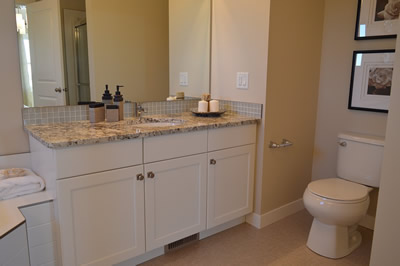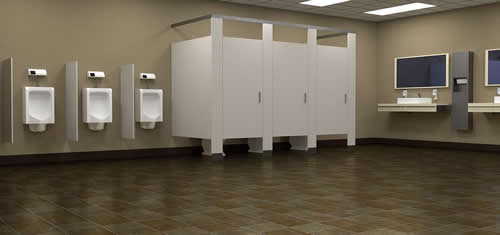Considerations for Adding a Basement Bathroom

Adding a bathroom in the basement can be beneficial in several ways. It adds value to the home, makes the basement more complete, and gives guests or residents an extra place to relieve themselves. However, before jumping into the project, homeowners need to get more familiar with what it entails.
Getting the wastewater to the sewer system is the main challenge of basement bathrooms. There are a few different options for doing this so read on to find out which one will work best:
Belowground
Many homes have a main sewer line situated in a way that the toilet and sink can be connected to it for disposal. With the help of gravity, everything will flow nicely into the existing line. In that situation, a backwater valve will be installed to prevent sewage backup into the basement bathroom.
Aboveground
There are a few different systems that fall under the aboveground option. There are the upflushing toilet, freestanding sewage-ejector systems, and composting toilets. They require a less invasive installation process, cutting down on costs.
- Upflushing Toilets
While the toilet itself is expensive, the installation of an upflushing toilet isn’t. Sitting on top of the floor, there’s no need for breaking concrete or any type of demolition.
- Sewage-Ejector Systems
Another option without breaking concrete is the sewage-ejector system. The toilet sits on top of this system, which is put in an enclosure. Everything that uses water in the bathroom will drain into the system, which then pumps the sewage into the drainage lines. This type of system does require all fixtures to be elevated a few inches so gravity can work its magic.
- Composting Toilets
The composting toilet system requires little to no water to work. However, it does need a vent to the outside. There is a limit to how much waste it can compost each day, which requires monitoring and emptying it when full. In a bathroom that doesn’t get much use, this could be a viable, environmentally friendly option.
Talk to All Star Plumbing and Restoration about adding a basement bathroom. We can help find the right solution for any basement.
Preventing Commercial Plumbing Mishaps

Businesses have enough to worry about during their day-to-day routine without thinking about the plumbing. When the plumbing has an issue, it can create chaos for a business. Instead of rushing to fix a problem when it happens, try to be proactive in dealing with the plumbing and any potential problems. Here’s how:
1. Regular Maintenance
It can’t be said enough. Regular maintenance of the plumbing can catch potential disasters before they occur. This will save the business money, and give them peace of mind. It also gives them time to save money and prepare for an entire re-plumb of the building or some other large project.
2. Check Appliances
Even between maintenance try to keep an eye on how appliances and fixtures are doing. Be aware of any red flags such as an unexplainable puddle of water. This could mean there’s something wrong with the appliance, and that water damage is present.
3. Educate Employees
When employees know how to spot potential problems, take care of minor mishaps, and understand the plumbing system, it makes life easier. Make sure they are aware of what can and can’t be flushed, tell them to be aware of leaks, and report them as soon as they are noticed.
Preventing issues in a commercial setting can be easy when thinking proactively. Because commercial plumbing systems generally cost more, trying to fix small issues before they turn into huge problems is key. These three practices should help in doing just that.
For commercial maintenance or emergency plumbing issues, call the team at All Star Plumbing and Restoration.
5 Items that Will Clog Pipes

Not everybody is in the know about what can and can’t go down the drain. Being unaware can be a costly mistake. Here are five common items that clog drains and toilets, forcing homeowners to call a plumber:
1. Fruit
There are a lot of people that recommend throwing a lemon wedge down the garbage disposal to make it smell fresher. However, the rind and peel don’t break down easily, which can clog the drain and dull the blades.
2. Grease
Disposing of grease, fats and oils can be difficult and a little unappetizing, but dumping them down the drain is not the solution. As they cool, they will create a sludge that builds up over time, restricting drainage. Instead, carefully empty grease into a heat-proof container and let it congeal before scraping it into the trash.
3. Hygiene Products
Nothing should go down the toilet except toilet paper. This includes those “flushable” wipes. Toilet paper is designed to disintegrate when it hits water, while “flushable” wipes and paper towels are not. Keep feminine products, cotton swabs, towelettes, etc. out of the toilet. Floss is also not biodegradable and should be thrown away.
4. Egg Shells
Another food myth related to the garbage disposal: egg shells sharpen the blades. This is false. The membrane attached to the shell can cause major problems for the shredder ring and the shells can clog the drain.
5. Starchy Foods
Starchy foods turn into a type of glue and expand when they cool down, which is exactly what they’ll do in the drain. This includes: artichokes, corn husks, asparagus, potatoes, pasta, etc. While the garbage disposal is meant to be used for food, use it strategically. Larger scraps should be thrown away.
For more garbage disposal tips, check out All Star Plumbing and Restoration’s website.
Turn PVC Pipes into Napkin Rings

Creating a beautiful table setting doesn’t have to be crazy expensive. Cut some costs by creating napkin rings out PVC pipes. They’re so cheap they can be made in every color for every occasion! Here’s what you need:
- 1-inch PVC pipes
- Handsaw or jigsaw
- Spray Paint
- Sand paper- 120 and 320 grit
- Spray paint acrylic sealer
- Old t-shirt
Instructions
- Using a saw, cut chunks of PVC pipe. They can be as thick or thin as wanted.
- Sand each chunk using the 120 grit first, then the 320. Wipe off the dust with an old t-shirt.
- Lay out the pieces and spray paint them. Let them dry, turn them over, and spray again. After the second coast is dry, do one more, light 3rd coat.
- Spray with the acrylic sealer
- Place cloth napkins in the rings
Past Plumbing Newsletters





